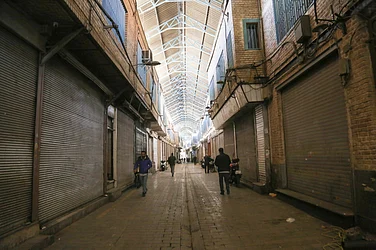Palestinians in Gaza reported intense bombardments near the southern towns of Khan Younis and Rafah, where Israel ordered civilians to seek refuge, early on Tuesday.
Details of causalities were not immediately available.
Israeli bombs hit areas west and southeast of Khan Younis and west of Rafah, according to local reports. Thousands of people trying to escape Gaza are gathered in Rafah, which contains the territory's only border crossing to Egypt, as international mediators press for a deal to allow aid in and refugees with foreign passports out.
The US hoped to break a deadlock over delivering aid to increasingly desperate civilians in besieged Gaza following a brutal attack by Hamas militants, as President Joe Biden was set to head to Israel and Jordan on Wednesday.
Aid workers warned that life in Gaza was near complete collapse because of the Israeli siege, with hundreds of thousands of people seeking shelter, ever-decreasing water supplies and power running out at hospitals.
At the Rafah crossing, Gaza's only connection to Egypt, truckloads of aid were waiting to go into the tiny, densely populated territory, and trapped civilians — many of them Palestinians with dual nationalities — were hoping desperately to get out.
Mediators were trying to reach a cease-fire to open the border, which shut down last week after Israeli airstrikes, but by early Tuesday it was unclear who was keeping the crossing closed.
Gen. Erik Kurilla, the head of US Central Command, arrived in Tel Aviv for meetings with Israeli military authorities ahead of a Biden visit planned for Wednesday to signal White House support for the country.
Biden will also travel to Jordan to meet with Arab leaders amid fears that the fighting could expand into a broader regional conflict.
US Secretary of State Anthony Blinken, who had returned to Israel after a six-country tour through Arab nations, said in Tel Aviv that the US and Israel had agreed to develop a plan to enable humanitarian aid to reach civilians in Gaza.
There were few details, but the plan would include “the possibility of creating areas to help keep civilians out of harm's way”.
Israel maintained punishing airstrikes across Gaza as a ground invasion loomed, while Hamas militants kept up a barrage of rocket attacks, and tensions mounted near the Israel-Lebanon border.
At least 2,778 people have been killed and 9,700 wounded in Gaza, according to the Health Ministry there. More than 1,400 Israelis have been killed, the vast majority civilians massacred in Hamas' October 7 assault.
The combination of airstrikes, dwindling supplies and Israel's mass evacuation order for the north of the Gaza Strip has thrown the tiny territory's 2.3 million people into upheaval and caused increasing desperation.
More than 1 million Palestinians have fled their homes, and 60 per cent are now in the approximately 14-kilometer-long (8 mile) area south of the evacuation zone, according to the UN.
In Gaza, hospitals were on the verge of losing electricity, threatening the lives of thousands of patients, and hundreds of thousands of Palestinians displaced from their homes searched for bread. With taps dry, many have resorted to drinking dirty or sewage-filled water, risking the spread of disease.
The Israeli military says it is trying to clear civilians for their safety ahead of a major campaign against Hamas in Gaza's north, where it says the militants have extensive networks of tunnels and rocket launchers. Much of Hamas' military infrastructure is in residential areas.
Those fleeing northern Gaza still faced airstrikes in the south. Before dawn Monday, a strike in the town of Rafah collapsed a building sheltering three families who had evacuated from Gaza City. At least 12 people were killed and nine others remained buried under rubble, survivors said.
Israel evacuated towns near its northern border with Lebanon, where the military has exchanged fire repeatedly with the Iranian-backed Hezbollah group. Israel fought a vicious monthlong war with Hezbollah in 2006 that ended in a stalemate and a tense detente between the two sides.
Speaking to the Israeli Knesset, Prime Minister Benjamin Netanyahu warned Iran and Hezbollah, “Don't test us in the north. Don't make the mistake of the past. Today, the price you will pay will be far heavier."
Soon after he spoke, the Knesset floor was evacuated as rockets headed toward Jerusalem. Sirens in Tel Aviv prompted US and Israeli officials to take shelter in a bunker, officials said.
Iran's foreign minister, meanwhile, warned that “preemptive action is possible” if Israel moves closer to a ground offensive. Hossein Amirabdollahian's threat followed a pattern of escalating rhetoric from Iran, which supports Hamas and Hezbollah.
The Israeli military said on Monday that at least 199 hostages were taken into Gaza, more than previously estimated. Hamas said it was holding 200 to 250 hostages.
Hamas' military wing released a hostage video showing a dazed woman having her arm wrapped with bandages. The woman, who identified herself as Mia Schem, 21, rocked slightly as she spoke, the sound of explosions reverberating in the background. Schem was taken from Kibbutz Reim, where she was attending a rave. Hamas said she had undergone a three-hour operation.
The plight of the hostages has dominated the Israeli media since the attack, with interviews with their relatives playing on television almost constantly. Israeli officials have vowed to maintain the siege of Gaza until the hostages are released.
In Gaza, more than 400,000 displaced people in the south crowded into schools and other facilities of the UN agency for Palestinians. But the agency said it has only 1 litre of water a day for each of its staff members trapped in the territory.
“Gaza is running out of water, and Gaza is running out of life,” said UNRWA chief Philippe Lazzarini, calling for a lifting of the siege. “We need this now.”
Hospitals are expected to run out of generator fuel in the next 24 hours, meaning life-saving equipment like incubators and ventilators will stop functioning and putting thousands of lives at risk, the UN said.
Yet doctors and many hospital staff have refused to evacuate, saying it would mean death for critically ill patients and newborns on ventilators.
In northern Gaza, unknown numbers remained, either unwilling or unable to leave. Hamas urged people to ignore the evacuation order. The Israeli military on Sunday released photos it said showed a Hamas roadblock preventing traffic from moving south.





















